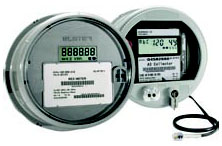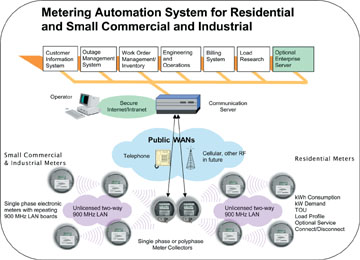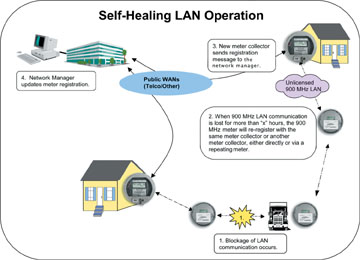
Metering technology is continually advancing in step with on-going advancements in microcomputer, memory, electronic assembly and communications technology. The innovative metering and communications technology available in today’s utility market is beginning to revolutionize the way utilities collect and use both daily usage and billing data.
Today there is a growing concern among industry groups, consumer groups, and legislators regarding the availability and pricing of energy. This article discusses how advancements in metering and communications technology are addressing those concerns for the energy provider and the consumer. Utilities in both regulated and deregulated markets are beginning to offer demand response programs that allow consumers to participate in the cost fluctuations of the wholesale energy market. In demand response programs, utilities pass on savings to consumers as they manually or automatically reduce their energy demand on days when wholesale energy prices peak. However, utilities face several barriers in implementing demand response programs. One of those barriers is the metering, communications, and computer system technology required by utilities to generate the daily usage data needed to enable residential consumers to participate in demand response programs.
At first look, the cost of populating residential areas with interval meters and the required system software appears prohibitive. Additionally, regulators in some areas have not addressed the issues of demand response pricing, the technology needed to implement it effectively, and who pays for infrastructure costs. These issues may inhibit utilities from investing in interval meters that were designed for large commercial and industrial (C&I) accounts just so they can offer their residential customers a demand response program. This is especially true in deregulated markets where a customer might not remain with a particular service provider for more than a couple of years.
Problems Inherent with Interval Data
Historically, interval data has been the chosen method for collecting daily load usage data at energy delivery points. For years, interval data recording has been used on large C&I utility accounts and at delivery point substations to provide daily usage of kW, kVAR, kVA, and power factor (PF). Until today, utilities had no choice but to use similar data recording devices to collect interval data from smaller C&I and residential accounts with the objective of providing hourly load use profiles for both the energy consumer and energy provider. In addition to providing load profile data, interval data has been used to compute total energy consumption, maximum demand, TOU energy, and to implement dynamic or critical tier pricing (CTP). The profile information is also used by utilities for load research studies that analyze usage patterns, support existing or planned rates, and to develop cost saving incentives and programs for residential consumers.
While it is widely accepted by utilities that billing data can be computed from interval data, there is some inherent risk in labeling the computed results as billing data. A data validation, editing, and estimation (VEE) process is required to confirm that collected interval data matches the true energy consumption seen at the meter. If a discrepancy is found, then a level of estimation and editing is required to account for the lost data, and this is not typically viewed as billing data, but is considered modified data. There is also a time element of interval data. Any skew in the real time relationship of interval data can have a dramatic impact on the computed demand and TOU data.
Additional attention for validation, editing, and estimation is given to interval data in instances where the stream of data is interrupted somewhere in the process. Such interruptions may occur because of a problem with the meter, the pulse initiator, the recording medium, or in the data transmission from the field site to the central office system. Also, power outages must be distinguished from net zero consumption periods. Validation verifies that the collected data matches the energy difference between the start and stop meter readings, and that the number of intervals collected matches the reported time between data collections. If any of the validation procedures fail, estimating and editing of the data is required. Very complex procedures are used by utilities to estimate lost data. Same-time data from similar accounts, same-time data from previous days for the same account, the average of the last several days and the same-date data from a year ago, plus other variations, have all been used to estimate the missing data. Most estimated data is biased in favor of the consumer so that a billing quantity would not be challenged as being artificially high. Even so, estimated interval data can be challenged and occasionally utilities need to make concessions for this.
Stand-alone electronic meters that support multi-season, multi-tier TOU rates have been available for several years. As more dynamic, critical tier pricing response programs are envisioned, there is a corresponding need to change peak billing time periods. Any change to the TOU program, perhaps on a daily basis, makes these types of meters unsuitable for implementing cost saving programs. Hence, within the utility industry there has been a perception that only interval data can be used to implement critical tier pricing. The interval data is used to reconstruct the dynamically changing critical tier billing data. However, by combining a multi-rate tier capable meter with two-way communications, consumption during critical peak periods can be easily routed to alternate rate storage registers in the meter, even if this occurs at different times on a daily basis. For example, a critical tier billing register could be engaged for two hours today, three hours tomorrow, one hour the next day, and so forth. When billing is due, the total energy used during critical peak periods is easily read from the meter. Thus the need for interval data is eliminated as a requirement to implement both TOU and real-time, critical tier pricing rates.
The Advantages of Collecting Billing Data Directly from the Meter
From previous experience, collecting interval data appears to be an expensive and burdensome solution for implementing demand response and other billing programs envisioned now or in the future. However, metering equipment manufacturers have developed new technology and now offer single phase electronic meters that provide demand, TOU and billing data directly from the meter. The need to collect interval data and compute billing data is no longer the only solution available. Residential electronic meters are available that can compute daily load usage, demand, and critical tier usage within the meter. The billing data is readily available to both the consumer and service provider locally at the meter via the meter display. Billing data can also be transmitted to remote metering automation systems using two-way communications. Even though these meters store and transmit billing data rather than interval data, these meters can also record interval data for load studies, but interval data is not necessary for the acquisition of daily energy usage and complex forms of billing data.

Metering Automation System Overview
Figure 1 shows an overview of how a metering automation system is deployed with meters that compute daily load usage and billing data within the meter. It uses standard, wide area network (WAN) communications like landline or cellular telephone to communicate with area meter collectors. The meter collectors in turn, manage a local area network (LAN) of meters using a repeating unlicensed 900 MHz radio frequency (RF) technology.
Several key features make this system unique from the other solutions on the market today.
- The flexibility of electronic metering offers multiple metering options on the same platform. Energy, bi-directional energy, demand, time-of-use, critical tier pricing, and load profile can be engaged at any time, on any meter in the system. This reduces metering costs, offers more flexible customer service and rate programs, and significantly reduces site visits and associated costs when new functionality is required to meet customer needs or competitive challenges.
- Obtaining billing data from the meter eliminates the discrepancies inherent in pulse-storage systems. There is no audit trail to follow with systems that attempt to recreate complex rates by storing data in the network or by reconstructing it from multiple pulse-based energy interval readings in the metering automation system. When the meter generates billing data, any data read remotely from the meter can also be read locally at the meter.
- The local area network data collectors are meters. Previously, radio-based metering automation network designs required mounting data collectors on pole-tops or streetlights to increase the coverage of the local 900 MHz RF network. Use of a repeating network greatly expands the meter collector coverage areas. Meter collectors can be either single phase or polyphase meters. The advantages of meter collectors are:
- Meter collectors cost less than pole-top data collectors
- Meter collectors are less expensive to install than pole-top data collectors. Units are installed at ground level, so no bucket trucks or crews are needed. Also, no special power wiring is needed
Meter personnel can install meter collectors, no special crews or coordination with distribution operations are needed - Meter collectors are easier to site, especially in areas with underground service and no utility poles
- Meter collectors are less expensive to maintain and operate
- The expanded capabilities of 900 MHz communications technology provide full twoway communications to each and every endpoint meter. Other communications system characteristics include:
- The ability to deploy a robust, repeating architecture. All meters on the LAN with 900 MHz two-way communications can function as an RF network repeater and each meter/collector can manage up to 1,024 meters on the LAN. This greatly expands the coverage area of the communications network around any given meter/collector and lowers system capital cost, lowers maintenance, and reduces communications expenses.
- Meters using two-way spread spectrum frequency hopping technology are selfregistering. The meters are installed like ordinary meters, with no special installation procedures required to set up the local area network, just plug-and-go. The meters automatically register with the meter collector, which in turn notifies the metering automation system of the meter registration. This self-registering process simplifies system installation and ensures the best communication path to every meter is obtained.
- The two-way communications network is self-healing. When local RF communication conditions change and a meter can no longer communicate with its meter collector, the meter automatically registers itself via an alternate path with the same or a different meter collector (see Figure 2). This greatly enhances communications throughput, improves reliability, and reduces system maintenance.

Metering automation systems available today are designed to meet the needs of utilities in both regulated and deregulated electricity markets and are suitable for either large-scale deployments or targeted applications such as hard to access, or high-turnover areas. These systems offer the benefits of a full two-way communications network and utilize advanced repeating unlicensed 900MHz RF architecture. When combined with electronic single phase meters that are capable of computing billing data within the meter, the system’s two-way communications capability and flexible functionality allow it to support many revenue-generating and cost-cutting services. The system’s architecture provides the following capabilities:
- Scheduled and on-request remote meter reading services for billing or other data needs
- Advanced energy measurement options, including energy in (delivered), energy out (received), sum, and/or net metering
- Implementation of consumption, demand, TOU and critical tier pricing rates, with no on-site visits for reprogramming or meter change-outs required
- Load profiling of selected meter locations
- Tamper indications and alarms
- Remote connect and disconnect in the meter
- Demand limiting in the meter
The Case for Intelligent Data Computing Meters
The advanced communication technologies used in metering automation systems allow service providers to do scheduled and on-request reads of energy consumption directly from the meter. The computation of energy consumption from interval data is not necessary. Energy usage can also be captured on a TOU schedule, stored in the meter, and read directly from the meter. Demand, a major attribute in identifying the energy requirements of individual consumers, is also measured at the delivery point and read directly from the meter. The data used for billing is not computed at a remote location with the assumption that all intervals of data are intact and have the correct time reference at the central computer. When using billing data retrieved directly from the meter, the need for estimated load usage and billing (which is usually biased towards the consumer) is virtually eliminated. The audit trail for billing data starts at the delivery point and the measurable performance and accuracy of the meter. Any problem with data is directly associated with the accuracy and performance of the meter that is providing the data. When billing data comes directly from the meter, the need to analyze interval data, and the time and resources needed to verify the meter accuracy, proper operation of the pulse initiator, interval timing, and the validity of the transfer process are eliminated.
Metering equipment manufacturers and their development teams are continually bringing innovative ideas and solutions to the utility industry. The innovative process of collecting billing data at the meter is available today. The notion that interval data is the only viable solution for collecting load usage and billing data is no longer valid. Single phase residential electronic meters that collect data, use two-way communications and are easily deployed in scalable metering automation systems provide utilities with an optimum solution. This cost-effective solution enables utilities to offer creative rates, demand, TOU energy, and dynamic pricing programs to customers who want to participate.
Today’s innovative metering technology is at the cusp of providing the business solutions that utilities need for tomorrow and in the future. These technologies and solutions provide an economical way for utilities to offer customers the opportunity to actively participate in daily price fluctuations of the wholesale energy market. Until now, interval data has been the only available solution for utilities to collect daily load usage data on residential and small commercial accounts. It is time for the utility industry to examine the more economical opportunities of reading billing data directly from an accurate metering device at the point of delivery. Collecting billing data directly from the meter permits utilities to implement complex rates using traceable data, and there are fewer issues that require estimates and edits to recreate billing data. With today’s available technology, billing data is traceable to a verifiable meter and not based on data that is computed, after the fact, at a remote location.
About the Author
John R. Goodman is a senior account executive of metering systems for Elster Electricity, LLC in Raleigh, North Carolina. John is a graduate of Texas Tech University and has worked for Westinghouse Electric Corporation, ABB Inc., and Elster Electricity where he is currently a senior account executive and proposal manager for the AMR Systems group. He has worked with electric utilities extensively throughout his career in the development and marketing of automated distribution, load management, meter data management and AMR systems. John has authored numerous papers on AMR systems, load management, and automated distribution. For more information contact john.r.goodman@us.elster.com







